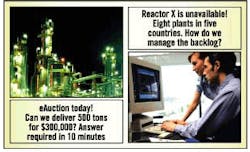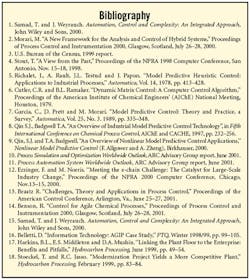The chemical and petrochemical industries traditionally have been highly receptive to new control and supervision technologies. These industries have invested more money and time in research and innovation than any other industrial sectors.Nevertheless, objective benchmarking criteria ," using the more innovative manufacturing sectors (automobiles, electronics, etc.) as a basis ," show that the efficiency of chemical plants is still far lower than its potential. Improvements could be achieved through the use of advanced computer technology.Throughout the history of industrial control, automation gradually has progressed toward higher levels of autonomy, the degree to which operations can be handled without human operators. In the process industries, model-based control has led to enormous progress in autonomy during the past 30 years. Process control began with simple configurations made up of a group of single-loop controllers, with little or no reciprocal coordination. Today, multivariable controllers optimize larger and larger production units. One "package" oversees functions that once could have been implemented only through the use of several different strategies (single-loop control, anti-windup, uncoupling to remove multivariable interactions, constraints management, delay time compensation, feed-forward management, economic optimization). This dramatic function integration, permitted by improvements in both the mathematical algorithms and the processing and memory capability of processors, means that human operators can focus on high-level actions and decisions. In the past, to control a distillation column using numerous single-loop regulators, operators had to set and monitor each single set-point value for flowrate, pressure and other variables that were only implicitly correlated to the end product's quality. A modern model-based architecture manages these execution details automatically and allows the operator to run the plant by generating commands directly related to the quantity and quality of the end product. One single operator can control a larger portion of the plant. It is possible to measure the level of autonomy of a control strategy by means of a special metric defined by the "number of loops to be supervised per operator." The higher this parameter, the higher the autonomy of the system implemented. Control systems autonomy has had an enormous impact in economic, environmental and human terms. In 1980, the U.S. refinery industry produced 5.3 billion barrels and employed 93,000 people. By 1998, production in this sector rose by 17 percent, while the number of employees dropped by 35 percent to approximately 60,000.The first on-line computer-based control system (103 inputs and 14 outputs) was put into service on a catalytic polymerization unit at a Texaco plant in Port Arthur, Texas, in 1959. In the early 1970s, multivariable model-based control was developed in parallel and independently in France and at the Shell research laboratories to optimize petrochemical and refining units.A census of industrial multivariable control applications by Qin and Badgwell in 1997 shows that 89 percent of these applications occurred in production units within the chemical sector, including refining, petrochemicals, specialty chemicals and pharmaceuticals. A second Qin and Badgwell survey on the introduction of even more innovative techniques in this field placed more than 82 percent of nonlinear control applications in the chemical sector.In 2000, the chemical industry invested just under $220 million in process simulation and optimization systems ," 65.2 percent of the total investment ($336 million) by all industries, including power, hydrocarbon extraction and distribution, food and beverage, pulp and paper, steel and iron and more. Yet, only 37 percent of total chemical-industry investments were in industrial automation.Despite the huge investments it has made in information technology, the chemical industry has been unable so far to achieve the performance of many other manufacturing sectors. Why? Experts have suggested a number of reasons, including: Knowledge deficit. Contrary to what occurs in discrete event systems, detailed knowledge of the production process often is not available in the chemical industry. The lack of full access to physical-chemical details gives rise to a relatively high degree of unpredictability and, therefore, of unreliability. Extreme technological diversification. It is difficult or impossible to standardize or fully duplicate procedures, technologies and operating practices. Riskiness of production. Labor-intensive, high-risk chemical processes with a high impact on the environment encourage a natural ," and understandable ," conservatism inside plants. This conservatism can result in resistance to change. Limited production flexibility. The average plant is large, complex and costly, and any changes to the setup and/or product are very complicated. Quick responses to economic trends or changing market demands are difficult. Complex logistics. Production processes often are distributed over vast areas and require movement of large quantities of material both within the production facilities and between sites. In recent years, most of the return on investments in business-to-business (B2B) has come from marketing and sales (the so-called e-commerce). However, e-commerce has a limited impact on the chemical industry, because so few customers and suppliers are involved in the supply chain. The true impact of B2B in this sector appears to be related to integration of production with logistics services. If the constant increase in autonomy is key to the evolution of industrial automation, the leading concept for contemporary business is agility. A business is considered agile when it is able to interact advantageously with global markets, adapt to their continual variations and produce high-quality goods/services oriented to the peculiarities of individual customers. If the chemical industry is to benefit fully from the opportunities offered by Internet-related technologies, its production processes must evolve from the "sell-from-stock" mode to the "make-to-order" mode. Fig. 1 shows two typical situations in which an easily reconfigured production setup makes all the difference.
Figure 1. Chemical Industry Production Challenges
Production processes must evolve from the sell-from-stock mode to the make-to-order mode.
Sensor systems
Automation and control are not merely a question of management software or sophisticated mathematical algorithms. Instrumentation that interacts with the physical world ," meaning sensors and actuators ," plays a fundamental role and will continue to do so in the future. Many future advances will depend on the ability to accurately and reliably measure the physical-chemical values of the systems to be controlled ," acquiring increasingly detailed knowledge of the process. Higher production efficiency, lower emissions and a greater degree of safety require the use of ever more sophisticated and precise sensors.The very concept of sensors currently is being revised and expanded. Instead of building on a single physical device, some sensors contribute to networks of instruments and/or software programs that are able to exploit analytical redundancies to correct and increase the reliability of existing measurements or to estimate new ones. Intelligent sensors connected by field buses, inferential sensors, and self-calibrating and/or self-compensating sensors will be key factors in process automation in the coming decade. More precise and cheaper sensors can be placed throughout the plant to produce more complete data for better production optimization. The wide-scale introduction of sensors of various kinds within the automobile industry is a clear precedent: A further lesson that can be learned from this sector is that economies of scale can reduce associated costs drastically.The increased use of sensors now allows better and more reliable environmental monitoring to rapidly identify sources of pollution. In the same way, preventive and predictive diagnostics will become more effective, especially for tasks that are not currently possible.Another area that stands to benefit from better sensors is asset management. Networks of dedicated sensors can promptly identify components and/or materials that are not used to their full potential. They can also replace or repair critical elements as soon as signs of malfunction are detected or before they jeopardize either safety or production continuity. However, all these tasks require not only better sensors, but also better and more careful integration of the sensors within automation systems.The computer infrastructure
The situations depicted in Fig. 1 require almost instantaneous decisions based on reliable real-time information concerning the plant's status and availability. This scenario is made possible only by the presence of a suitable computer infrastructure connecting the separate worlds of process control and enterprise resource management. Information flows from each single device in the field to the management offices (called device-to-enterprise [d2E]). Numerous applications function in synergy, drawing information from a single data repository.This dual function is effectively performed by modern process information management systems (PIMS). PIMS: Interface the various control and basic monitoring systems to gather process data, with sampling times of a second or less. Integrate the data gathered into the real-time databases. Convert all significant values and store them in large, efficient relational databases that permit sophisticated off-line analyses. Validate and reconcile with each other the values most useful in defining the operational status of the plant. Deliver the subset of data most relevant to strategic production management at critical times and in specified formats. At a higher PIMS level, operative process management software made up of a series of applications helps supervise operations, checks the progress of the production plan, manages maintenance and explores any margins for improvement in the production cycle. Last, enterprise resource planning (ERP) systems perform business-cycle management. These systems integrate the information related to plant status, obtained from suitably reconciled data, with data from other production sites, financial data and market opportunity data. It is at this level that the whole supply chain is managed.The execution capability
The computer infrastructure is the channel through which the transactional level is kept informed about the status of the plant and logistics, thus enabling context-sensitive production plans. Similar attention must be paid to optimization of the channel through which the flow of orders is implemented. See Fig. 2.Figure 2. The Three Main Contributions to Process Automation
Plants must aim to optimize the channel through which the flow of orders is implemented.
To use an image familiar in the world of automation, the equivalent of a control loop is created: The plant's execution capability corresponds to the actuator's action, and the monitoring performed by the PIMS is the feedback channel (the controller would be the strategic company management). As any control engineer knows, no control loop can work properly if either one of these two channels is not up to the task. Here too, the greater the involvement of the company in the world of e-commerce, the greater the demands for performance from the order implementation system. Chemical plants have to work in available-to-promise (ATP) and/or capable-to-promise (CTP) modes to seize transitory trade opportunities such as the purchase of raw materials at reverse auctions or an unrepeatable opportunity to satisfy the short-term needs of customers.The need to increasingly enlarge the execution capability of the process is driving companies to embrace sophisticated process optimization and control techniques. It is now widely held that the most effective control and optimization strategies must incorporate active working knowledge of the process.
Applying advanced automation and control
Part One of this article looked at some of the process control and automation challenges faced by the chemical industry, as well as some prerequisites for meeting these challenges. Part Two (January 2003) will provide some specific plant application examples of how properly planned and implemented solutions improved plants' bottom lines. CPBonavita is manager of ABB's International Advanced Process Control Group, and Martini is the manager of Advanced Process Control group with ABB in Italy. They can be reached at [email protected] and [email protected], respectively. The authors also would like to thank Mr. Eugenio Sciallero of ABB Solutions, whose contributions to this article were of great value.





